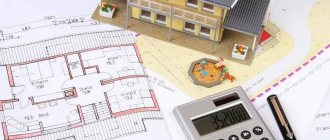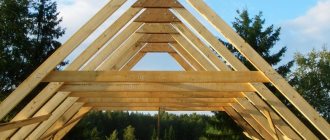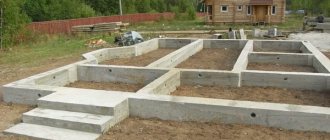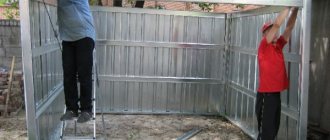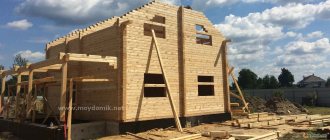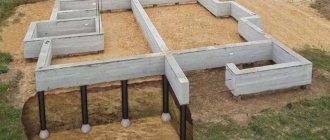People associate the construction of a private house with huge financial expenses. In reality, it turns out that everything is not so scary and terrible - if you carry out construction correctly and according to the instructions, you can even save a little.
Next, we should look at the question of how much it costs to build a house using a certain material. Approximate calculations will be given that you should focus on if you have a desire to live in a private house separate from everyone else.
How much does it cost to build a house from foam blocks?
In the last few years, houses made of foam blocks have begun to spread; builders themselves are actively introducing them, stipulating the simplicity and cost-effectiveness of the financial plan.
But when making the appropriate calculations, it becomes clear that foam blocks are not such an economical material, since the cost of a turnkey house is made up of the following points:
- Architectural plan of the project and its approval by government agencies. You can carry out documentary confirmation yourself, which will significantly save money. Collecting documents, approving the project and obtaining a construction permit will require from the owners of the future building from 25 thousand rubles (excluding the cost of the agents’ work).
- Next, they begin to pour the foundation, and in the story with foam blocks you can save a little. Due to the low mass of the basic material, a conventional lightweight foundation with reinforcement is suitable for a one-story house. The average cost of purchasing composite components for concrete varies from 180 to 220 thousand rubles - depending on the area of the future building.
- Laying out a plinth made of foam blocks requires 5-6 rows of standard blocks. This is approximately 70-80 thousand rubles.
- Next, the walls are laid, which, depending on the house, can require up to 150 thousand rubles - this is approximately 13-14 rows of foam blocks.
- Roofing frame – fixed cost of 5% of the total work estimate. In this case, it is about 50 thousand rubles. The roof covering can vary, so its cost is much more difficult to determine. For example, if you cover a roof with tiles, you will need to purchase material in the amount of 35 to 100 thousand rubles - it all depends on the cost of a sheet of tiles and the area of the house.
Based on the results presented above, it turns out that the construction of a one-story house made of foam blocks will require no more than 700 thousand rubles. For Moscow and the Moscow region, and for Russia as a whole, this amount is not exorbitant and unattainable.
But the calculations presented take into account only the construction of the house itself, without communications and other equipment.
It is not rational to take the presented expenses into account, since each owner of a future home weighs his needs against his material income, as a result of which internal communications and finishing can be done for either 500 thousand rubles or 1.5 million rubles. The minimum cost of construction of the entire house is 1.5 million rubles.
Nuances associated with deadlines for completing work
In situations where the start and completion dates of work fall on different reporting periods, the norms of PBU 2/2008 apply (approved by order of the Ministry of Finance dated October 24, 2008 No. 116n). Due to the nature of the process, construction almost always falls under the provisions of PBU 2/2008. Thus, accounting of construction projects is carried out in the manner provided for by PBU 2/2008 “as soon as they are ready.”
To understand the essence of the method, let us dwell in a little more detail on such an important definition as “construction object”. In accordance with the Town Planning Code of the Russian Federation dated December 29, 2004 No. 190-FZ, a construction project is not a temporary structure or structure. Let us note that in the order of the Ministry of Finance dated December 20, 1994 No. 167, which was in force before the adoption of PBU 2/2008, on the accounting of contracts for capital construction, there was one more characteristic - the presence of a separate estimate or a separate project for a building, structure, structure. Now this norm is not specified.
According to the current PBU 2/2008, in order to determine the object for accounting, it is necessary to study the agreement (agreements) and technical documentation:
- The following should be considered as a separate agreement (and, therefore, an accounting object): an object for which there is separate documentation (presumably, including an estimate or project, which was discussed in the “old” regulations);
IMPORTANT! Even if one agreement has been concluded for a complex of objects, each of which has the characteristics of a separate object, accounting must be kept for each object separately, as if an independent agreement had been concluded for each.
- an object for which income and expenses can be determined with a reasonable degree of reliability.
- all contracts essentially relate to a single object for which uniform accounting standards are established (for example, for profit);
For each accounting object determined according to the above criteria, it is then necessary to determine one of 2 possible ways to determine income and expenses:
- by the share of completed work in the total volume of work under the contract (facility);
- by the share of costs already incurred as of the reporting date in the total volume of planned construction costs.
Let's talk briefly about the first method. It consists of assessing the volume of work already completed as of the reporting date in physical terms. As a rule, such an assessment is an expert assessment. In addition, if the work is submitted in stages, you can conduct an assessment based on documented completed (passed) stages. In this case, the part of them that relates to recognized revenue should be written off as expenses.
Find out how to confirm costs for materials during construction in the expert solution from ConsultantPlus. Get trial access to the system and access the material for free.
The second method is based on determining, as of the reporting date, the share of costs already incurred in the total volume of planned costs under the contract. Since this method is directly related to cost accounting methods in construction, let us consider the procedure for accounting for income and expenses using this method using an example.
Example
The total amount of the contract concluded on January 12 is 30 million rubles. The amount of expenses determined by calculations (estimates) is 20 million rubles. The advance received from the customer in January amounts to 8 million rubles. The amount of costs already incurred under the contract as of March 31 amounted to 5 million rubles. Documents confirming the acceptance of the work performed by the customer were issued in April. The contractor determines the readiness of the work based on the share of costs incurred. What will be reflected in the contractor's accounting? (For simplicity, VAT is not included in the example).
For details about the nuances of VAT accounting for a contractor, see: “When to charge VAT to a contractor?”
- We determine the share of expenses already incurred in the total construction costs:
5 million rub. / 20 million rub. × 100% = 25% - degree of readiness of the object.
- We determine the share of conditionally earned revenue based on the degree of readiness of the object:
30 million rub. × 25% = 7.5 million rubles.
- To account for the stages of work performed, account 46 “Completed stages of work” of the Chart of Accounts is used (approved by order of the Ministry of Finance dated October 31, 2000 No. 94n).
| Dt | CT | Amount (rub.) | Decoding | Note |
| 51 | 62 | 8 000 000 | Advance payment from the customer is reflected | As of date of receipt (January) |
| 20 | 10, 70, 69, 02, 60, 76 | 5 000 000 | Accumulated costs incurred for the completed stage of work | For the period from the date of conclusion of the contract to the reporting date. |
| 46 | 90 | 7 500 000 | The cost of work performed is reflected to calculate the financial result for the period | By the “as ready” method on March 31. |
| 90 | 20 | 5 000 000 | The share of expenses related to the work performed was written off to calculate the financial result | As of March 31 |
Upon completion of all work, when the final settlement documents are issued to the customer, the entire amount under the contract will be reflected in the accounting:
DT 62 CT 46 – 30 million rubles.
Thus:
- account 62 will show the balance of the customer’s debt under the contract;
- Account 46 will reflect the remaining amount of work to be included in revenue upon completion of construction.
NOTE! All the above actions are based on calculated (i.e. planned) indicators: contract price, estimate, design documentation. In fact, various deviations from the values established at the beginning of construction almost always occur.
How much does it cost to build a brick house?
A brick house - this is it, an unattainable dish for the people of Russia. But even this seemingly unattainable dream may turn out to be quite real, since approximate calculations for building a house please the eye with a low figure.
To convince ordinary people of this, we should give an example of a calculation for the construction of a standard one-story house measuring 81 square meters. m (9x9 m):
1. For such a house you need a good strip foundation with reinforcement. The required volume of concrete for the foundation is about 55 cubic meters. m.
If the foundation must be 1.6 m deep, then 4 horizontal rows of reinforcement are required. Based on general calculations, together with formwork and work on the foundation, about 250 thousand rubles are required.
2. Next comes brickwork - this is the most expensive stage, both physically and financially. If the house has 81 sq. m, which means that one floor will require about 9 thousand bricks.
In Moscow, high-quality bricks can be purchased for 12 rubles apiece. As a result, it will take only 108 thousand rubles to purchase a brick.
But this is not the only material - you will need cement and sand, water. Additional materials cost about 25 thousand rubles.
A construction company requires up to 1,500 rubles per 1 sq.m. for laying a wall with 1 brick. m. House of 81 sq. m. m is about 100 sq. m when calculating a ceiling height of 2.7 m.
It turns out that the construction company will have to pay about 150 thousand rubles for the work - this is only the external walls of the house. As a result, brickwork can require up to 500 thousand rubles, including sealing seams and laying out door and window openings.
3. Roof - for a house of 81 square meters. m requires a gable roof, the area of which is about 125 sq. m. m.
This requires:
- wooden materials worth 9 thousand rubles (plus supports worth 4 thousand rubles),
- covering with tiles (for example) of 80 sheets and the amount of 36 thousand rubles,
- insulation 145 sq. m of mineral wool worth 4 thousand rubles,
- other fittings in the form of ridges and drainage systems worth over 70 thousand rubles.
The amount of materials can reach 150 thousand rubles. If we talk about construction work, then for the installation of the rafter system you will have to pay about 70 thousand rubles, and the installation of the roof - about 60 thousand rubles.
The cost of installing the roof also takes into account the installation of the ridge and other work, which will also require up to 50 thousand rubles from the client.
As a result, installation of the roof with construction work costs 330 thousand rubles.
It turns out that the cost of building a brick house without interior decoration is 1 million 80 thousand rubles. Interior decoration is still a minimum of 700 thousand rubles. The final minimum cost of building a brick house is 1 million 800 thousand rubles.
Since brick houses are about aesthetics, quality, and durability, the presented cost does not turn out to be so inflated. The only unpleasant point is the cost of land plots in Moscow and the immediate Moscow region.
How much does it cost to build a house out of brick? Video:
Nuances associated with discrepancies between planned and actual costs
The first main point that distinguishes accounting according to PBU 2/2008 from other standards is that when certain cost items change, revenue is subject to adjustment. This happens in the following cases:
- If during construction work, for objective reasons, more expensive materials or more complex technology (and also more expensive) methods of performing work were used. At the same time, revenue is adjusted upward.
- If during the work, for some reason, part of the work was not completed (without prejudice to the result of construction). In this case, revenue is adjusted downward.
- If upward changes in costs occur due to the fault of the customer. For example, the contractor was forced to incur additional costs due to the technology of work that were not taken into account in the estimate provided by the customer. In such a situation, revenue is adjusted upward by presenting a special requirement to the customer.
- Another case of adjusting revenue is if the contract provides for incentive payments to the contractor. For example, for meeting deadlines for completing work.
In all these cases, you should change the amount of revenue reflected on the credit of the 90th account. In this case, the amounts of additional costs collected on account 20 are subject to debit to account 90:
- as part of the cost of the completed stage of work, if the customer recognized and paid additional costs;
- as part of other expenses for ordinary activities, if the customer did not recognize and pay for these expenses.
The second important aspect of cost accounting in construction is a specific approach to the classification and accounting of indirect costs.
Only those costs that are compensated by the customer under the terms of the contract are subject to distribution to the cost of the contract and, accordingly, to accounting and write-off according to the above principles. For example:
- costs of insuring the facility (refer to general production costs and are accounted for on account 25);
- costs for technical support and expert support for the work performed (also related to general production costs);
- costs of maintaining the contractor's management staff (the provision for compensation must be specified in the contract as a separate clause. These costs are classified as general economic costs and are accounted for on account 26).
All other expenses not included in the contract are considered expenses for the contractor for ordinary activities and are subject to accounting and write-off in the period in which they were incurred.
Find out how to correctly account for construction costs if you apply the simplified tax system “income minus expenses”, using the advice of ConsultantPlus experts. If you do not have access to the system, get a trial online access for free.
IMPORTANT! Expenses that do not produce a production result (for example, construction defects) cannot be included in the contract value in any case. Such expenses are always written off in the period in which they occur.
For information on how specific construction costs are taken into account, read: “Accounting and taxation in construction (nuances).”
How much does it cost to build a frame house?
Modern technologies have reached their apogee - now frame houses are offered for construction, the cost of which is much lower than the usual brick buildings. A frame house is the use of modern SIP panels and other materials.
Their quality and heat preservation properties allow people to live in houses for a long time - it is possible to organize the construction of a full-fledged house, but such implementations are not recommended for regions with a harsh winter climate.
Frame houses are much cheaper to build and quicker to build, which is why they are preferred today.
As an example, we should consider the cost of building a two-story house, the area of which is within 140 square meters. m – the walls of the first floor are 7.5x13 m, the walls of the second are 6x7 m. The cost of the work is presented as follows:
- The foundation is piles or a simple strip foundation without the introduction of reinforcement. Piles will require no more than 80 thousand rubles, and a strip foundation will cost more than 100 thousand rubles.
- Frame and cladding - depending on the cladding, the cost of work and material may require up to 250 thousand rubles.
- Insulation is mandatory in a frame house, so you will have to shell out another 80 thousand rubles.
- Roofing materials cost only 200 thousand rubles.
- Interior decoration and windows are approximately 700 thousand rubles (you can calculate the cost of materials of average cost, so it is better to count on a price of 1 million rubles).
It turns out that building a house - the external frame - can cost only 650 thousand rubles. With other additional costs for interior decoration to a minimum, this is a final amount of approximately 1 million 300 thousand rubles.
Individual characteristics of the construction process
Despite the fact that accounting in construction in the Russian Federation is carried out on the basis of general requirements and regulations, it is characterized by a large number of individual features. The reason for the presence of these features is the specifics of the construction process. For this article, we will highlight the following as the main individual characteristics of the construction site:
- Duration of execution of contract agreements. As a result, the start of work and its completion usually belong to different reporting (including tax) periods.
- The following feature follows from the atypical duration of the work cycle: phasing. Both delivery to the customer and payment by the customer usually take place in several stages. This leads to specificity in the formation of revenue and cost.
- With regard to the formation of cost in construction, there are also a number of special techniques and methods. The main purpose of these methods is, if possible, to compensate for the uncertainty in the reliability of the assessment of the financial result of the construction project being taken into account. On the one hand, based on accounting principles, receiving advances from construction customers does not provide sufficient confidence that revenue can be determined on the basis of these advances. On the other hand, the planned cost indicators determined during the work also cannot be considered completely suitable values for taking them into account in expenses when forming the financial result.
Let us examine in more detail the accounting features arising from the above aspects.
How much does it cost to build a house from aerated concrete?
Aerated concrete is a type of concrete similar to foam block. Based on its not so attractive appearance, such buildings are advised to be additionally clad. The cost of building a one-story house of a standard area - with walls 8x9 m - is presented as follows:
- It is better to make the foundation strip with additional reinforcement. As already calculated above for a brick house, the cost of materials and work will be 250 thousand rubles.
- Walls cost approximately 400 thousand rubles. The calculation takes into account aerated concrete blocks for the external and internal walls. The external walls are thicker - 400 mm, the internal ones can be thinner - 250 mm.
- External wall cladding – up to 150 thousand rubles.
- A rafter system with work costs 80 thousand rubles.
- Roof - above we have already taken the calculation using tiles, from which it follows that it is necessary to shell out up to 300 thousand rubles.
- Interior decoration - communications, equipment and formation of walls - minimum 700 thousand rubles.
It turns out that building a house from aerated concrete is not so cheap. After all, in total you will have to spend 1 million 880 thousand rubles. The advantage of building with aerated concrete is the speed of work.
Moreover, it retains heat perfectly, so there is no need for external cladding when it comes to thermal insulation.
Having saved 150 thousand rubles, you can build a house from aerated concrete for only 1 million 730 thousand rubles. The quality is not inferior to a brick house, and you can build it yourself - this is not a brick that has to be laid out “with jewelry.”
How much does it cost to build a house in 2022? Video:
Standardization of direct costs is another important nuance of construction
From the above, one significant conclusion can be drawn - during the construction process, accounting is carried out based on calculated indicators. In order for the final result to not differ much from the planned one, strict planning and cost regulation are necessary.
IMPORTANT! Rationing of costs in construction is carried out not only for accounting purposes. Construction is one of the most highly regulated industries, so setting and complying with standards is mandatory from both a technology and safety point of view, as well as several other parameters.
First of all, the contractor's direct costs accounted for in account 20 are subject to rationing. These include:
- cost of materials and structures used;
- wages of construction workers;
- depreciation of own construction equipment;
- rental of construction equipment;
- transportation and procurement costs related to the items listed above (for example, costs of moving equipment and machinery).
How standards are set in practice can be read here: “We approve standards for the write-off of building materials.”
How much does it cost to build a house from timber?
Houses made of timber are attracting future owners of a private home more and more. An attractive appearance, warmth, and reliability of the structure are integral factors that people consider when calculating the cost of building a house.
Calculation of the cost of building a one-story house 8x8 m is presented as follows:
- Foundation – a house made of timber does not require a full foundation. There are enough piles with foundation blocks here. To build a foundation for a log house of this size, 20 piles and the same number of blocks are required, so you will have to spend about 50 thousand rubles. The construction company will charge about 70 thousand rubles for the work.
- Frame – here it is better to choose ready-made timber frames. The approximate cost of the indicated area is 750 thousand rubles. As a rule, internal partitions are already provided here, so you won’t have to pay anything extra. You can also order its installation from the company where the frame is purchased - this is approximately 30% of the cost of the frame itself. For the above example, it turns out to be 225 thousand rubles.
- The roof costs about 300 thousand rubles already calculated from the tiles.
In the calculations, part of the interior decoration should be removed, which in the examples is indicated as an average of 700 thousand rubles. Since the frame is provided ready-made, you can safely remove 100 thousand.
It turns out that the total cost of building a house made of timber is about 2 million rubles. Yes, beams are a luxury; they should not be confused with logs and a finished frame.
Building a house from a log house can cost only 1.5 million rubles, but the log house is not particularly pleased with its thermal insulation.
Do-it-yourself smart home technology. What it is? - there is more useful information here.
Results
Accounting for costs when performing construction work is always carried out for a designated object (contract) and is inextricably linked with accounting for revenue from construction work. The fact of recognition of revenue (or part of it) allows us to recognize costs associated with this revenue. Wherein:
- direct costs are subject to accounting as part of the contract according to established standards;
- indirect costs are included in the cost of the contract only to the extent that they are included in the contract and are compensated by the customer;
- other costs incurred in the current period are included in the expenses of this period
Basically, when accounting for costs in construction, the same accounting accounts are used as in production. However, the use of account 46 is also typical, due to the fulfillment of the requirements of PBU 2/2008.
Sources:
- Tax Code of the Russian Federation
- PBU 2/2008, approved. by order of the Ministry of Finance of Russia dated October 24, 2008 N 116n
You can find more complete information on the topic in ConsultantPlus. Free trial access to the system for 2 days.
